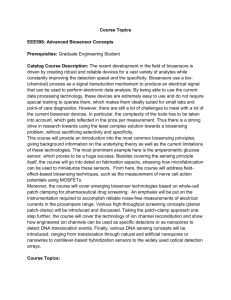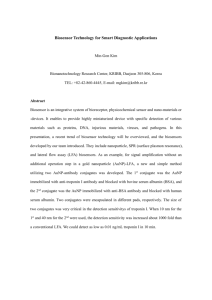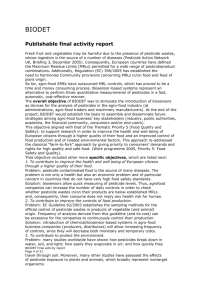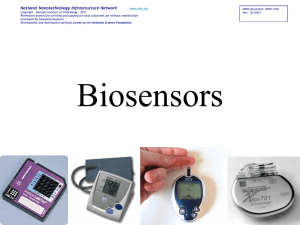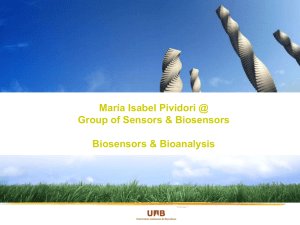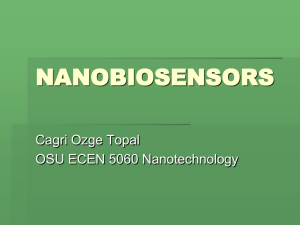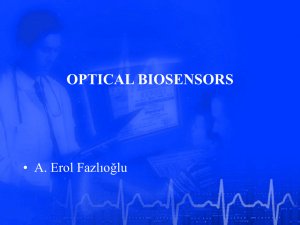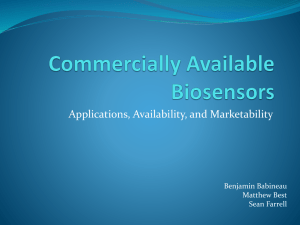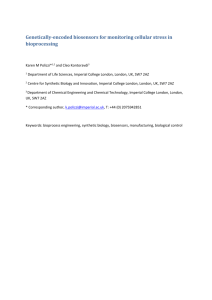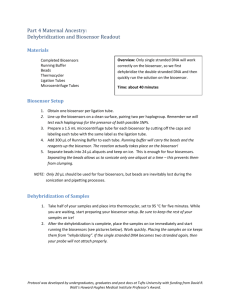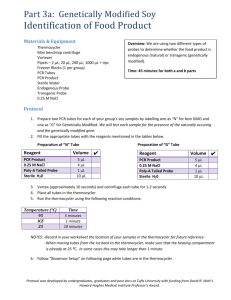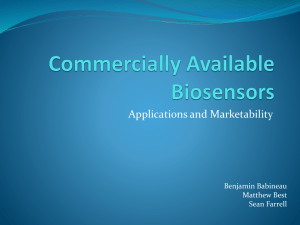DOC
advertisement
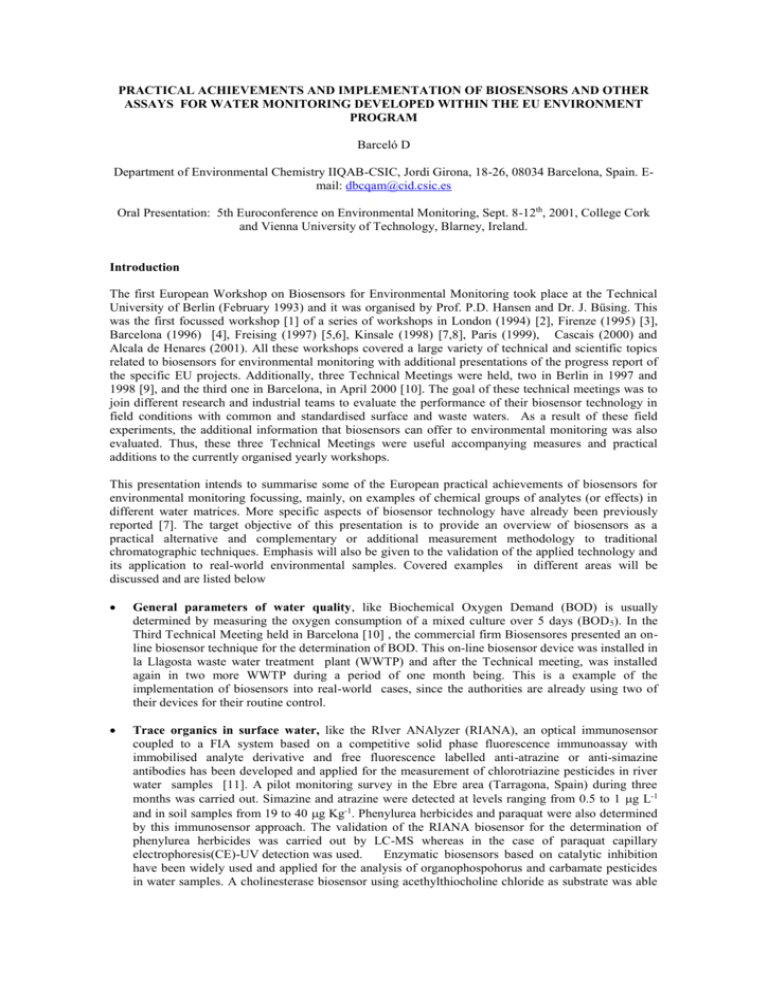
PRACTICAL ACHIEVEMENTS AND IMPLEMENTATION OF BIOSENSORS AND OTHER ASSAYS FOR WATER MONITORING DEVELOPED WITHIN THE EU ENVIRONMENT PROGRAM Barceló D Department of Environmental Chemistry IIQAB-CSIC, Jordi Girona, 18-26, 08034 Barcelona, Spain. Email: dbcqam@cid.csic.es Oral Presentation: 5th Euroconference on Environmental Monitoring, Sept. 8-12th, 2001, College Cork and Vienna University of Technology, Blarney, Ireland. Introduction The first European Workshop on Biosensors for Environmental Monitoring took place at the Technical University of Berlin (February 1993) and it was organised by Prof. P.D. Hansen and Dr. J. Büsing. This was the first focussed workshop [1] of a series of workshops in London (1994) [2], Firenze (1995) [3], Barcelona (1996) [4], Freising (1997) [5,6], Kinsale (1998) [7,8], Paris (1999), Cascais (2000) and Alcala de Henares (2001). All these workshops covered a large variety of technical and scientific topics related to biosensors for environmental monitoring with additional presentations of the progress report of the specific EU projects. Additionally, three Technical Meetings were held, two in Berlin in 1997 and 1998 [9], and the third one in Barcelona, in April 2000 [10]. The goal of these technical meetings was to join different research and industrial teams to evaluate the performance of their biosensor technology in field conditions with common and standardised surface and waste waters. As a result of these field experiments, the additional information that biosensors can offer to environmental monitoring was also evaluated. Thus, these three Technical Meetings were useful accompanying measures and practical additions to the currently organised yearly workshops. This presentation intends to summarise some of the European practical achievements of biosensors for environmental monitoring focussing, mainly, on examples of chemical groups of analytes (or effects) in different water matrices. More specific aspects of biosensor technology have already been previously reported [7]. The target objective of this presentation is to provide an overview of biosensors as a practical alternative and complementary or additional measurement methodology to traditional chromatographic techniques. Emphasis will also be given to the validation of the applied technology and its application to real-world environmental samples. Covered examples in different areas will be discussed and are listed below General parameters of water quality, like Biochemical Oxygen Demand (BOD) is usually determined by measuring the oxygen consumption of a mixed culture over 5 days (BOD 5). In the Third Technical Meeting held in Barcelona [10] , the commercial firm Biosensores presented an online biosensor technique for the determination of BOD. This on-line biosensor device was installed in la Llagosta waste water treatment plant (WWTP) and after the Technical meeting, was installed again in two more WWTP during a period of one month being. This is a example of the implementation of biosensors into real-world cases, since the authorities are already using two of their devices for their routine control. Trace organics in surface water, like the RIver ANAlyzer (RIANA), an optical immunosensor coupled to a FIA system based on a competitive solid phase fluorescence immunoassay with immobilised analyte derivative and free fluorescence labelled anti-atrazine or anti-simazine antibodies has been developed and applied for the measurement of chlorotriazine pesticides in river water samples [11]. A pilot monitoring survey in the Ebre area (Tarragona, Spain) during three months was carried out. Simazine and atrazine were detected at levels ranging from 0.5 to 1 g L-1 and in soil samples from 19 to 40 g Kg-1. Phenylurea herbicides and paraquat were also determined by this immunosensor approach. The validation of the RIANA biosensor for the determination of phenylurea herbicides was carried out by LC-MS whereas in the case of paraquat capillary electrophoresis(CE)-UV detection was used. Enzymatic biosensors based on catalytic inhibition have been widely used and applied for the analysis of organophospohorus and carbamate pesticides in water samples. A cholinesterase biosensor using acethylthiocholine chloride as substrate was able to distinguish between different batches of water containing 3-10 ppb levels of pesticides in water [12]. . Organic pollutants in wastewatersTyrosinase biosensors have also been widely used to determine phenols in natural waters and wastewaters and their results have been compared with those obtained with the so called phenol index [6]. A paper is in press , within the project INEXsPORT that compares three types of phenol biosensors for characterising phenol content in WWTP during the third field experiment held in Barcelona in 2000 [10, 13] The group from University of Alcala de Henares had the tyrosinase screen printed electrode into a flow injection system whereas the group form Postdam University and BST Berlin had a portable prototype device with integrated biosensor using (GDH) modified thin-film electrodes and the group from the University of Lund used a cellobiose dehydrogenase (CBH) biosensor coupled into a flow injection system. These groups have made a real-good comparison of their devices, they have calibrated their instruments with the standards supplied by the CSIC and they have analysed the real samples. Toxic and endocrine disrupting effects There are different ways of measuring toxicity. One of the most extended is the use of Microtox ® or the recently developed ToxAlert@ system. Although they are not strictly biosensors, they are a kind of bioprobes used in a standardised way to measure toxicity of the effluents. They are widely accepted and internationally recognised.During the Third Field Experiment held in Barcelona, Spain [10] more data has been generated and a variety of cytotoxic compounds were identified in wastewater treatment plant during this field experiment [14].. The efficiency of the WWTP was evaluated by collecting and analysing samples at various stages of the water treatment process. The chemical compounds identified could explain the toxicity observed at the different steps of the WWTP. Endocrine disrupting effects are widely studied nowadays. One of the most current measurements is the so-called vitellogenin (VTG) level in male fish. If VTG levels are high as compared to control values, exposure to endocrine disrupting chemicals can be concluded. This approach has been used for the development of a biosensor called VITELLO within the EU project PRENDISENSOR. Within the EU project SANDRINE different biosensors, bioassays and receptor assays are being developed for detecting endocrine disrupting compounds in WWTP. In this respect, MCF-7, ELRA and vitellogenin (VTG) are few of the different assays in use. A practical example was the determination of the presence and the effects of endocrine disrupting compounds in two tributaries of the Llobregat river (NE Spain), water samples and carps, Cyprinus carpio, were collected from selected sites along a transect, for chemical and biological determinations, respectively [15]. Western blot analysis of male carp plasma using a polyclonal antibody raised in the cyprinid Koi carp, detected this protein in all samples, the VTG increase being more evident at the vicinity of the treatment plants. Certain correlation was also found between NP in water and VTG induction in fish (r = 0.75). Conclusions All these results show some of the European efforts to implement biosensor technology and other assays, including toxic assays and ELISA, to environmental analysis. The developments achieved during the last 8 years of the different EU Environment Programs have permitted to show some key examples of the applications of biosensors for environmental monitoring demonstrating not only cost-effective alternatives for screening but also effect related readouts where new and unpredictable approaches are expected. Biosensor technology has reached maturity for BOD, pesticides, and phenols incorporating whole cells, affinity or catalytic events with electrochemical or optical transduction. Complex and difficult analytes (e.g. surfactants) are progressively approached by biosensors. The large variety of analytes, the complexity of environmental matrices, the low limits of detection, and the legislative compliance should not shadow the progress achieved in this area. On the contrary, biosensor research is offering new strategies for the evaluation of biological effects where cocktails of compounds may show synergistic or antagonistic effects that will remain unsolved by chromatographic or spectroscopic techniques. The challenge for environmental biosensors remains open and further research in this area will only prove that new parameters are needed for safer and more complete environmental risk assessment. It is expected that collaborative work, focussed research and interdisciplinary approaches may lead to biosensor indexes that will certainly contribute to a better knowledge and characterisation of environmental samples. The Technical Meetings showed that biosensors are useful tools for controlling the degree of pollution of surface waters and of WWTP. All biosensors evaluated showed much higher “alarm”values for the influent waste waters as compared to the final treated WWTP effluent. This is already remarkable, since the main advantage of the different biosensors evaluated, like BOD, ToxAlert or phenols, is that the measurements are being down very rapidly-maximum 20 minutes, so the information is available immediately. This is certainly an advantage over conventional methods that require several days, either for the BOD-5 or for conventional chromatographic/mass spectrometric methods. Acknoweldgemtns This work has been fudned by the the European Union Environment and Climate Program through the Waste Water Cluster project SANDRINE (ENV4-CT98-0801) and by the Conceterda Action " Evaluation/Validation of Novel Biosensors in Real Environmental and Food Samples" from the European Union Quality of Life and Management of Living Resources Program (QLK3-CT-200001311) References 1. First European Workshop on Biosensors for Environmental Monitoring. Technologies for Environmental Protection, Report 2. EUR 15014 EN. ISBN 2-87263-097-X. Editors A.P.F. Turner, J. Wilkinson, H. Sauer and J. Büsing, European Commission, Brussels-Luxembourg, 1993, pp 1-86 2. Second European Workshop on Biosensors for Environmental Monitoring. Technologies for Environmental Protection, Report 2EUR 15622 EN. ISBN 92-826-2711-X. Editors P. Bennetto and J. Büsing, European Commission, Brussels-Luxembourg, 1994, pp 1-246 3. Third European Workshop on Biosensors for Environmental Monitoring. Technologies for Environmental Protection, Report 9 EUR 16762 EN. ISBN 92-827-6605-5. Editors: J. Büsing, B. Pippich and A.P.F. Turner, European Commission, Brussels-Luxembourg, 1996, pp 1-278 4. Fourth European Workshop on Biosensors for Environmental Monitoring. Technologies for Environmental Protection , Report 14 . ISSN 1018-5593. Editors: D. Barceló and A.P.F. Turner, Barcelona, 1996, pp 1-196 5. Biosensors for Environmental Diagnostics. Editors: B. Hock, D. Barceló, K. Camman, P.D. Hansen and A.P.F. Turner. Edited by B.G.Teubner, Stuttgart-Leipzig in the Teubner-Reihe Umwelt series. ISBN 3-8154-3540-4. Leipzig, 1998, pp 1-280. 6. Special issue of Analytica Chimica Acta, vol 362, No 1 (1998) pp 1-112. Elsevier, Amsterdam, Holland. 7. Biosensors for Environmental Monitoring: Technology Evaluation. Editors: C. O’Sullivan, G. Guilbault, S. Alcock and A.P.F. Turner. Cork, 1998. 8. Special issue of Analytica Chimica Acta, vol 387, No 3 (1999) pp 225-330. Elsevier, Amsterdam, Holland. 9. 1st and 2nd European Technical Meetings Biosensors for Environmental Monitoring. Editors: P.D. Hansen, J. Köhler and D. Nowak. Berlin 1997 and 1998. 10. BIOSET: Biosensors for Evaluation of the Performance of Waste Water Treatment Works, CSICEU, Barcelona, 2000, 128 pags. Eds D. Barceló, J. Dachs and S. Alcock 11. E. Mallat, C. Barzen, A. Klotz, A. Brecht, G. Gauglitz and D. Barceló, Environ. Sci. Technol., 33 (1999) 965-971. 12. D. Barceló, S. Lacorte and J.L. Marty, Trends Anal Chem., 14 (1995) 334-340. 13. C. Nistor et al., Anal. Chim Acta (2001) in press 14. M. Farre et al., Anal. Chim Acta (2001) in press 15. M Sole et al., Environ. Sci Technol 34 (2000) 5076-5083.
